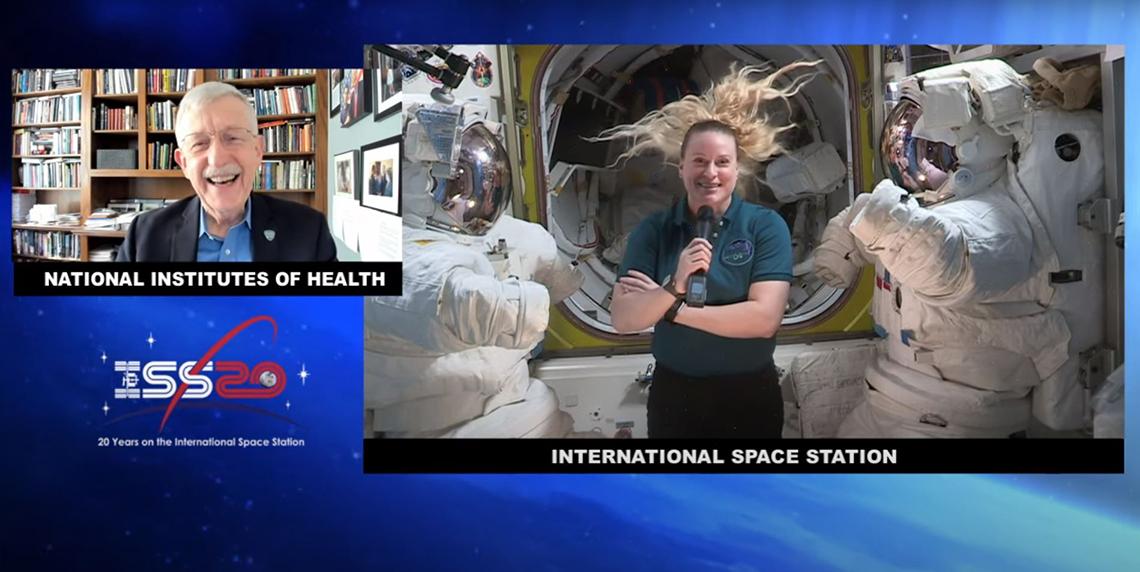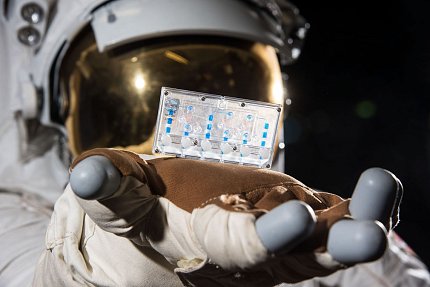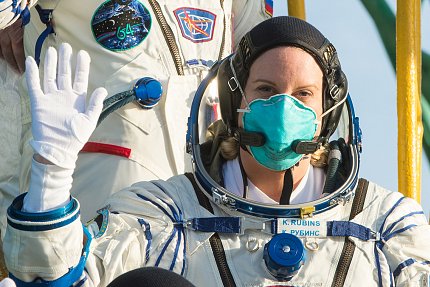Low-Tech Remedies to the Rescue
Astronaut Updates Collins on Scientific Progress Aboard ISS

Velcro and tape are advancing molecular biology in microgravity, the unique environment where the effects of Earth’s gravity are minimal, said NASA astronaut and biologist Dr. Kate Rubins while aboard the International Space Station.
“One of the hardest parts about doing laboratory science here is that you can have a bench, but nothing will stay on the bench,” said Rubins, during a recent chat with NIH director Dr. Francis Collins. “It moves around, and it walks away and it floats off the second you stop looking at it.”
These low-tech solutions allow astronauts to understand health, disease and aging in space and the implications on Earth and to sequence the DNA of microbes that live on the space station.
“We’re all fascinated by the way in which science is being conducted there on the International Space Station,” said Collins.
Since 2016, NCATS has partnered with NASA to launch the Tissue Chips in Space initiative. Tissue chips are tiny 3-D models that contain living human cells, such as heart or bone, grown on an artificial scaffold. These chips mimic essential functions of the human body.

Photo: NCATS
“These tissue chips are super exciting for understanding the effects of space flight on the human body. But it’s not just all about NASA,” Rubins explained. “One of the things that we’re looking at with these is how we can replicate some disease processes on Earth.”
Collins said biomedical researchers are always looking for disease models that more accurately represent human physiology and pathology.
One such study using a cartilage-bone-synovium joint tissue chip focuses on the effects of microgravity on musculoskeletal diseases, such as osteoarthritis and bone loss.

Photo: NASA/GCTC/Andrey Shelepin
In microgravity, astronauts lose bone density. Once they return to earth, astronauts regain their bone density. However, the trabecular structures—what gives bones their strength—do not come back even in healthy, younger space travelers. To counteract these effects, Rubins said, astronauts lift weights.
The bone loss astronauts undergo in space is similar to bone loss that older adults experience on Earth. Because these physiological changes happen more quickly in microgravity than they do on Earth—reducing the timeline from years to months or even weeks—using tissue chips in space to study bone loss could speed the discovery of therapeutics that prevent cartilage and bone loss resulting from the normal aging process.
During an earlier stay aboard the ISS, Rubins demonstrated for the first time that it’s possible to sequence DNA in space. Her lab features a small sequencer the size of a cell phone because “larger sequencing machines are just not super suitable for the space environment.”

Photo: NASA
One of the reasons for conducting the experiment was to identify microorganisms living on the ISS in real time. Previously, astronauts swabbed surfaces aboard the ISS, put the samples on a culture and sent them back to Earth for identification. The process depended on when a space vehicle returned to Earth.
Right now, she is using a method called multiplex sequencing to identify what lives in the richest microbial locations (including the astronauts themselves) on the ISS. There is no dirt on the ISS and supplies are packaged in cleanrooms before they are sent up to the station to reduce microbial counts.
Once she has data, Rubins hopes to determine what microbes grow best in microgravity and radiation and learn more about astronauts’ microbiomes. In the future, the technology might be one tool of many to help identify unknown DNA-based life forms on other planets.
“This is the best time to be a scientist in the history of the planet because so many things are possible even on planet Earth and even in the space station,” said Collins. Rubins agreed, “It’s truly amazing to get up and discover new things.”
This was their second “space chat.” Rubins has also visited NIH to celebrate National DNA Day to talk about science in space.
